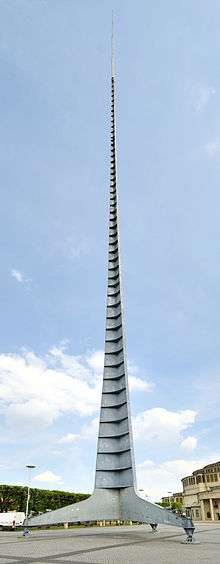Iglica
Iglica (Polish: [iɡˈlʲit͡sa]; "spire" or "needle")[1] is a needle-like monument in Wrocław, Poland. It was built in 1948 and was 106 metres tall. Today, after renovation, the top ten metres have been removed and it is now 96 metres tall.

This structure was constructed by Polish Communists for an exhibition to celebrate regaining control over the "Regained Territories" after the Second World War. The Iglica is located very close to the Centennial Hall.
Originally topped by a spinning contraption of mirrors, creating an "umbrella of light" at night, this was struck by lightning within a day of completion, and prior to the official opening. The remnants of this damaged structure were apparently removed by two climbing enthusiasts at no cost, the military being unable to tackle the task.[2]
The spire was named one of Poland's official national Historic Monuments (Pomnik historii), as designated April 20, 2005, together with the Four Domes Pavilion, the Pergola, and Centennial Hall. Its listing is maintained by the National Heritage Board of Poland.
See also
- Spire of Dublin – similar design with a height of 120 metres, but of stainless steel and newer.
- List of towers
References
- "Translation of iglica – Polish–English dictionary". Cambridge Dictionary. Retrieved 2020-04-14.
a tall, pointed tower, especially one built on the roof of a church.
- "Iglica". Wrocław In Your Pocket. 2019-12-10. Retrieved 2020-04-14.